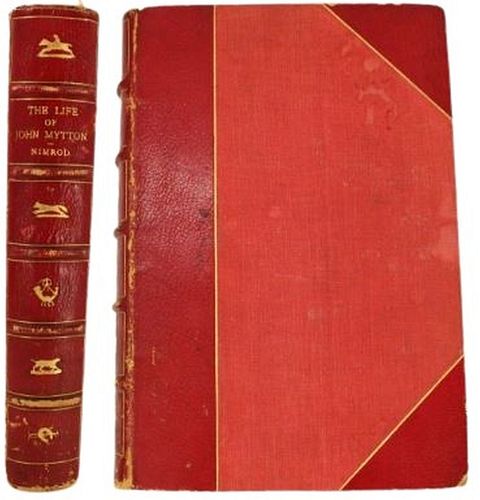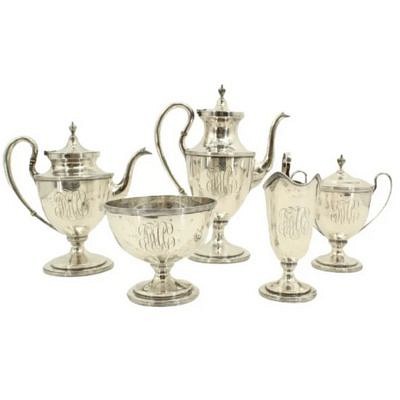Nimrod, Memoirs of The Life of The Late John...
About Seller
522 South Pineapple Avenue
Sarasota, FL 34236
United States
Sarasota Estate Auction specializes in a wide variety of furniture, antiques, fine art, lighting, sculptures, and collectibles. Andrew Ford, owner and operator of the company, has a passion for finding the best pieces of art and antiques and sharing those finds with the Gulf Coast of Florida.
Two ways to bid:
- Leave a max absentee bid and the platform will bid on your behalf up to your maximum bid during the live auction.
- Bid live during the auction and your bids will be submitted real-time to the auctioneer.
Bid Increments
| Price | Bid Increment |
|---|---|
| $0 | $10 |
| $100 | $25 |
| $250 | $50 |
| $1,000 | $100 |
| $2,500 | $250 |
| $7,500 | $500 |
| $20,000 | $1,000 |
| $50,000 | $2,500 |
| $100,000 | $5,000 |
| $250,000 | $10,000 |
About Auction
Jan 20, 2024
Artists to include: Jorge Blanco, Leonardo Nierman, Picasso, LeRoy Neiman, Darrell Crisp, Francois Krige, Mino Delle Site, Peter Max, Edward Povey, Sky Jones, Robert Rauschenberg, and others. There are also 7 Original Charles Schulz Drawings done by Reuben Timmins, Production Cels, over 200 lots of Important Books and Manuscripts, Sterling Silver, a Jane Kostick Geometric Wooden Sculpture, Modern Design and Furniture, Fantastic Estate Jewelry, and so much more! Sarasota Estate Auction sarasotaestateauction@gmail.com
- Lot Description
This hunting book is titled "Memoirs of The Life of The Late John Mytton, Esqre, Of Halston, Shropshire, Formerly M.P. for Shrewsbury, High Sheriff for the Counties of Salop & Merioneth, and Major of the North Shropshire Yeomanry Cavalry. With Notices of his Hunting, Shooting, Driving, Racing, Eccentric, And Extravagant Exploits … With Numerous Illustrations by H. Alken and T. J. Rawlins. Reprinted (with considerable Additions) from the New Sporting Magazine", written by Nimrod and printed by Ballantyne, Hanson & Co. in Edinburgh and London and published by Kegan Paul, Trench, Tribune & Co., with no publishing date on the title page, but probably published around 1890 because of the merger dates for Kegan Paul. The first edition was published by Rudolph Ackermann in 1835 and the second edition in 1837. Charles Kegan Paul (1828 - 1902) was an English author, publisher, and former cleric who purchased the publishing department of the firm Henry S. King & Co. in 1877, and Paul renamed the firm C. Kegan Paul & Co. After a fire in 1883, the firm was amalgamated with another publisher, George Redway, and the heirs of Nicholas Trübner. The new firm merged in 1889 and became Kegan Paul, Trench, Trübner & Co. Ltd, and they moved into larger premises in 1891. John Ramage (1836 - 1911) was a bookbinder who was born in London and listed as a London bookbinder, according to records at the British Library. He worked with the distinguished Marcellin Lortic after serving an apprenticeship with John Wright, and in 1860 he bought the binding business of Alexander Banks, Jr. in Edinburgh, he returned to London three years later, where he opened his own shop and stayed in business into the early 1900's. His bindings were celebrated for their remarkably delicate, careful, and elaborate gilt work. The book is 3/4 bound, with five raised bands, gilt lettering and gilt hunting devices on the spine, marbled endpapers, stamped "Bound by Ramage, London" at the bottom of the first blank endpaper, a colored frontis by H. Alken showing horses jumping during a fox hunt, the vignette title page, a twelve-page Note on Henry Alken's "Mytton" (iii - xiv), four pages of Biographical Notes (xv - xviii), a three-page Preface, three pages of Contents, a one-page List of Plates - there are twenty beautifully colored plates, including the frontispiece, all with captioned tissue guards - 234 pages of text, and the top edge is gilt. Nimrod was the pseudonym for Charles James Apperley (1778 - 1843), a Welsh sportsman and writer who published his works on the chase and the turf under the name "Nimrod"; between 1805 and 1820 Apperley devoted himself to fox-hunting and contributed articles to The Sporting Magazine on horse racing, hunting meets and other sporting events; he was considered an invaluable recruit to the sporting press of the times, and he might even have created the role of a gentleman hunting correspondent. Writing under several pseudonyms, he published his first article as Nimrod for the Sporting Magazine in 1822 and used that pen name for the most part afterwards. For five seasons, from 1824 to 1828, he was the magazine's official representative, with a contract that gave him £1500 a year, a remarkably high salary designed to cover his traveling expenses and the upkeep of a string of hunters, so he was highly regarded in sporting circles. John Mytton (1796 - 1834), or "Mad Jack", was a real person who was indeed eccentric, a hunting and sporting squire who got expelled from Westminster and Harrow Schools and was not awarded a degree when he attended Cambridge University; he saw some military service as part of the occupation of France after Napoleon was defeated, and he was a captain int the county yeomanry, then played at being a Tory MP, but soon resigned because he found Parliament boring. As master of foxhounds from 1818 to 1821, he hunted a vast country extending from Halston to Staffordshire, including the country of the Albrighton hunt. In the 1820's, when he hunted around Halston with new hounds and harriers, he flouted many established hunting conventions: he kept a large racing stable, but never bred a good horse, he was a splendid shot and a daring horseman, and there are numerous stories of his recklessness - he is said to have galloped at full speed over a rabbit warren just to see if his horse would fall, which it did and rolled over him. Again, for a wager he drove a tandem at night across country, jumping over a sunken fence three yards wide, with a broad deep drain and two stiff quickset hedges. He would sometimes strip to his shirt to follow wildfowl in bad weather, it's said once he stripped naked to follow a duck over the ice, he set his shirt on fire to get rid of the hiccups, he was a heavy drinker, and after numerous crazy exploits, he spent all his inheritance and died in debtors' prison. Henry Thomas Alken (1785-1851) was a painter and engraver of sporting scenes who often worked with Nimrod. The book measures 10 1/2 x 7 1/2 in. wide, with a tight binding and very clean pages, text, and plates. There's rubbing on the raised bands, light rubbing at the crown and heavier rubbing at the heel, rubbing along the edges of the spine and along the edges of the boards, spots on the boards and wear at the tips, and the plates and pages inside the book are very worthwhile. They give you a glimpse of 19th century English hunting and sporting with a keen eye of the author, the artist, and the subject himself, who was just an absolute rake. The first edition from 1835 goes for around $1700, so you're getting a good bargain here. #99 #1638
- Shipping Info
-
SHIPPING INFORMATION·
Sarasota Estate Auction IS NOT RESPONSIBLE FOR SHIPPING. All shipping will be handled by the winning bidder. Sarasota Estate Auction recommends obtaining shipping quotes before bidding on any items in our auctions. If you are interested in obtaining any information on local shippers, please send us an email and we will kindly send you a list of local shippers. Refunds are not offered under any circumstances base on shipping issues, this is up to the buyer to arrange this beforehand.
Premier Shipping, info@premiershipment.com
BIDDER MUST ARRANGE THEIR OWN SHIPPING. Although SEA will NOT arrange shipping for you, we do recommend our shipper Premier Shipping & Crating at info@premiershipment.com You MUST email them, please do not call. If you'd like to compare shipping quotes or need more options, feel free to contact any local Sarasota shippers. You can email any one of the shippers below as well. Be sure to include the lot(s) you won and address you would like it shipped to. Brennan with The UPS Store #0089 - 941-413-5998 - Store0089@theupsstore.com AK with The UPS Store #2689 - 941-954-4575 - Store2689@theupsstore.com Steve with The UPS Store #4074 - 941-358-7022 - Store4074@theupsstore.com Everett with PakMail - 941-751-2070 - paktara266@gmail.com
-
- Payment & Auction Policies
-
Available payment options
We accept all major credit cards, wire transfers, money orders, checks and PayPal. Please give us a call at (941) 359-8700 or email us at SarasotaEstateAuction@gmail.com to take care of your payments.
-
- Buyer's Premium



 EUR
EUR CAD
CAD AUD
AUD GBP
GBP MXN
MXN HKD
HKD CNY
CNY MYR
MYR SEK
SEK SGD
SGD CHF
CHF THB
THB































